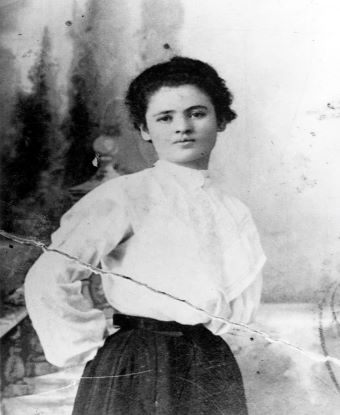Last updated: May 4, 2021
Person
Clara Lemlich Shavelson

Credit: Tamiment Library
Clara Lemlich Shavelson is known primarily for her part in the 1909 garment workers strike in New York City, often referred to as the Uprising of 20,000. At the time, immigrants dominated New York City garment industry jobs, with many of the low-skilled positions going to immigrant women. Employees worked long hours, often in dangerous conditions for low wages with no protections. In these working conditions, collective action through the union labor movement proved crucial to the well-being of workers in the garment trade.
Born in Ukraine in 1886, Shavelson emigrated to the United States with her family in 1904. In New York City, she found work in a garment factory. She officially joined the International Ladies’ Garment Workers' Union (ILGWU) in 1906 and was a member of her local executive board. With her emphasis on “revolutionary thinking” and willingness both to speak her mind and put her physical safety on the line, Shavelson became well known in the garment trades as an agitator and organizer for workers’ rights, and was instrumental in strikes in several factories between 1906 and 1909. She led worker strikes at both the Weissen & Goldstein Factory and the Leiserson Factory, and was a regular speaker on picket lines around Manhattan.
Her star turn came in November 1909. Taking the stage at a union meeting at Cooper Union, following several union leaders, including American Federation of Labor president Samuel Gompers and Women’s Trade Union League President Mary Dreier, Lemlich demanded action–a strike. Recalling the strike years later, Lemlich noted that she was compelled to speak: “[I] had fire in my mouth,” she explained.1
After the strike, Shavelson found work as an organizer for the Wage Earners Suffrage League. Building on her experience leading strikes, she tied the demand for the vote to labor struggles. Shavelson framed them as part of the same fight— as women working to support their families, they wanted their voices heard, both in the workplace and in government. While she had commanded respected from male garment workers as a union leader, her involvement in the women’s suffrage movement led them to throw rotten tomatoes at her “when they saw her talking up suffrage to women workers” outside of garment factories.2
In 1912, she married, moved to Brooklyn, and started a family, leaving garment work, and exchanging union and suffrage organizing for a different kind. In Brooklyn, she organized women in her neighborhood–wives and mothers–to engage in consumer activism such as food boycotts and rent strikes. For Shavelson, the personal was political, and she was well aware of the effects that collective action, could have, whether from a group of workers or of housewives. She believed that sweeping social change was necessary and possible. Her beliefs led her to join the Communist Party, where she found others who were committed to revolutionary thinking in the same way she was. In a conversation with her daughter Martha, Shavelson said of her move away from organized labor that “the great majority of workers merely believe you have to get a little more pay. A Communist wants more than that. You joined for a higher life.”3
Mindful of her early days without access to education, Shavelson organized reading and discussion groups for housewives in her neighborhood. She ran for New York City and State office, and campaigned for other candidates whose vision she believed in. She raised money for unions out on strike, and led delegations of people to City Hall and to Washington, D.C. in support of lower food prices, federal unemployment, and world peace. Along with her husband Joe, she raised her children in an activist household.
Shavelson ended a 1965 letter recounting her involvement in the 1909 strike by saying that “insofar as I am concerned, I am still at it.”4 True to her word, Shavelson convinced the administration of her retirement home in California to support the United Farm Workers produce boycott, and helped the nurses there organize for union representation. She died in California in July 1982.
—
Notes
[1] Von Drehle, Dave, Triangle: The Fire that Changed America (New York: Atlantic Monthly Press, 2003), 9.
[2] Orleck, Annelise, Common Sense & a Little Fire: Women and Working-Class Politics in the United States, 1900-1965 (Chapel Hill: University of North Carolina Press, 1995), 99.
[3] Orleck, Annelise, Common Sense & a Little Fire: Women and Working-Class Politics in the United States, 1900-1965 (Chapel Hill: University of North Carolina Press, 1995), 223.
[4] Shavelson, Clara Lemlich, “Remembering the Waistmakers General Strike, 1909,” in A Documentary History of the Jews in the United States, 1654-1875, ed. Morris U. Schappes (New York: Schocken Books, 1971).
